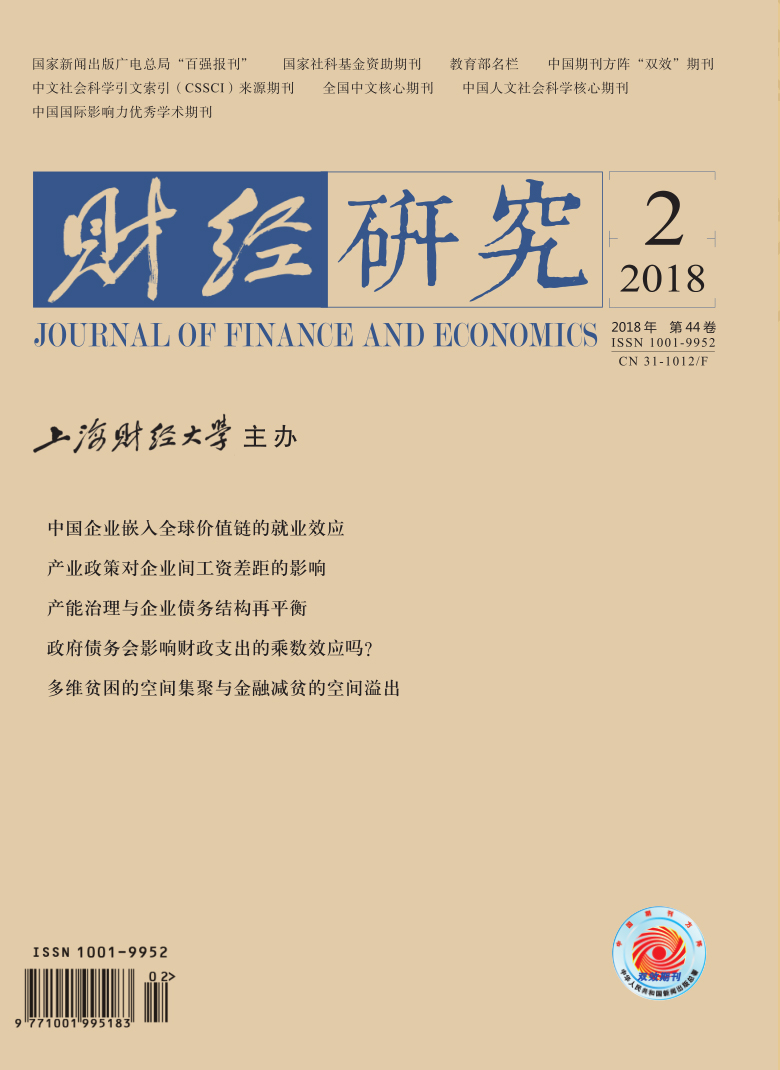文章在构建一个局部均衡模型的基础上,采用150个国家(地区)2000−2014年的面板数据,实证考察了政府债务对财政支出乘数效应的影响,得到了与理论预期一致的经验证据。结果表明:(1)政府债务会显著影响财政支出的乘数效应。随着政府债务水平的提高,财政支出的乘数效应趋于减弱。尤其是在克服内生性问题之后,这一结论仍然成立;(2)政府债务作用存在显著的非线性特征。当政府债务占GDP的比重突破88%的阈值后,财政支出的乘数效应会在低债务国家和高债务国家之间发生非常迅速的逆向转换;(3)对中国这样的低债务国家,顺周期的财政政策运用是非常有效的。而对美国、希腊等已经处于高债务水平的国家,采取逆周期的财政政策才能避免潜在的经济波动风险。
政府债务会影响财政支出的乘数效应吗?——自跨国面板数据的经验证据
摘要
参考文献
1 陈强. 高级计量经济学及Stata应用[M]. 北京: 高等教育出版社, 2014.
2 程宇丹, 龚六堂. 政府债务对经济增长的影响及作用渠道[J]. 数量经济技术经济研究, 2014, (12): 22—37.
5 郭步超, 王博. 政府债务与经济增长: 基于资本回报率的门槛效应分析[J]. 世界经济, 2014, (9): 95—118.
8 王国静, 田国强. 政府支出乘数[J]. 经济研究, 2014, (9): 4—19.
9 王仕进, 刘杰. 政府债务、期限溢价与货币政策选择[J]. 财经研究, 2017, (11): 128—139.
10 Aghion P, Hemous D, Kharroubi E. Cyclical fiscal policy, credit constraints, and industry growth[J]. Journal of Monetary Economics, 2014, 62(1): 41—58.
11 Agnello L, Fazio G, Sousa R M. National fiscal consolidations and regional inequality in Europe[J]. Cambridge Journal of Regions, Economy and Society, 2016, 9(1): 59—80. DOI:10.1093/cjres/rsv033
12 Baldacci E, Petrova I, Belhocine N. Assessing fiscal stress[R]. IMF Working Paper, 2011.
13 Barro R J. Inflation and economic growth[J]. Annals of Economics and Finance, 2013, 14(1): 121—144.
14 Baum A, Checherita-Westphal C, Rother P. Debt and growth: New evidence for the Euro area[J]. Journal of International Money and Finance, 2013, 32: 809—821. DOI:10.1016/j.jimonfin.2012.07.004
15 Bi H. Sovereign default risk premia, fiscal limits, and fiscal policy[J]. European Economic Review, 2012, 56(3): 389—410. DOI:10.1016/j.euroecorev.2011.11.001
16 Blanchard O J, Leigh D. Growth forecast errors and fiscal multipliers[J]. American Economic Review, 2013, 103(3): 117—120. DOI:10.1257/aer.103.3.117
17 Borensztein E, Cowan K, Valenzuela P. Sovereign ceilings " lite”? The impact of sovereign ratings on corporate ratings[J]. Journal of Banking and Finance, 2013, 37(11): 4014—4024. DOI:10.1016/j.jbankfin.2013.07.006
18 Buchanan J M. Public finance in democratic process: Fiscal institutions and individual choice[M]. NC: UNC Press, 2014.
19 Cimadomo J, Bénassy-Quéré A. Changing patterns of fiscal policy multipliers in Germany, the UK and the US[J]. Journal of Macroeconomics, 2012, 34(3): 845—873. DOI:10.1016/j.jmacro.2012.02.006
20 Coale A J, Hoover E M. Population growth and economic development[M]. NJ: Princeton University Press, 2015.
21 Cochrane J H. Understanding policy in the great recession: Some unpleasant fiscal arithmetic[J]. European Economic Review, 2011, 55(1): 2—30. DOI:10.1016/j.euroecorev.2010.11.002
22 Corsetti G, Meier A, Müller G J. What determines government spending multipliers? [J]. Economic Policy, 2012, 27(72): 521—565. DOI:10.1111/ecop.2012.27.issue-72
23 Eggertsson G B. What fiscal policy is effective at zero interest rates? [J]. NBER Macroeconomics Annual, 2011, 25(1): 59—112. DOI:10.1086/657529
24 Hassan M K, Sanchez B, Yu J S. Financial development and economic growth: New evidence from panel data[J].The Quarterly Review of Economics and Finance, 2011, 51(1): 88—104. DOI:10.1016/j.qref.2010.09.001
25 Hürtgen P, Rühmkorf R. Sovereign default risk and state-dependent twin deficits[J]. Journal of International Money and Finance, 2014, 48: 357—382. DOI:10.1016/j.jimonfin.2014.05.020
26 Ilzetzki E, Mendoza E G, Végh C A. How big (small? ) are fiscal multipliers? [J]. Journal of Monetary Economics, 2013, 60(2): 239—254. DOI:10.1016/j.jmoneco.2012.10.011
27 Leeper E M, Walker T B, Yang S C S. Fiscal foresight and information flows[J]. Econometrica, 2013, 81(3): 1115—1145. DOI:10.3982/ECTA8337
28 Mendoza E G, Yue V Z. A general equilibrium model of sovereign default and business cycles[J]. Quarterly Journal of Economics, 2012, 127(2): 889—946. DOI:10.1093/qje/qjs009
29 Nickel C, Tudyka A. Fiscal stimulus in times of high debt: Reconsidering multipliers and twin deficits[J]. Journal of Money, Credit and Banking, 2014, 46(7): 1313—1344. DOI:10.1111/jmcb.2014.46.issue-7
30 Pereira A M, Andraz J M. On the economic effects of public infrastructure investment: A survey of the international evidence[J]. Journal of Economic Development, 2013, 38(4): 1—37.
31 Ramey V A. Identifying government spending shocks: It's all in the timing[J].Quarterly Journal of Economics, 2011, 126(1): 1—50. DOI:10.1093/qje/qjq008
32 Ramey V A. Can government purchases stimulate the economy[J]. Journal of Economic Literature, 2011, 49(3): 673—685. DOI:10.1257/jel.49.3.673
33 Walker D. Trends in US military spending[M]. NY: Council on Foreign Relations, 2013.
34 Zubairy S. On fiscal multipliers: Estimates from a medium scale DSGE model[J]. International Economic Review, 2014, 55(1): 169—195. DOI:10.1111/iere.12045
引用本文
林峰, 赵焱. 政府债务会影响财政支出的乘数效应吗?——自跨国面板数据的经验证据[J]. 财经研究, 2018, 44(2): 58–74.
导出参考文献,格式为:
上一篇:人民币汇率与城乡收入差距





 10650
10650  11480
11480

